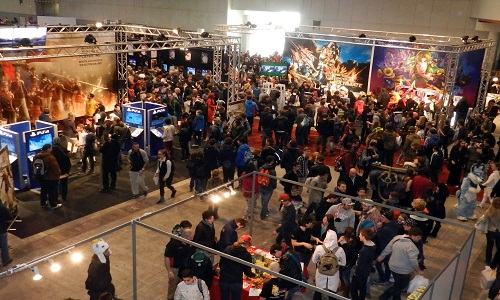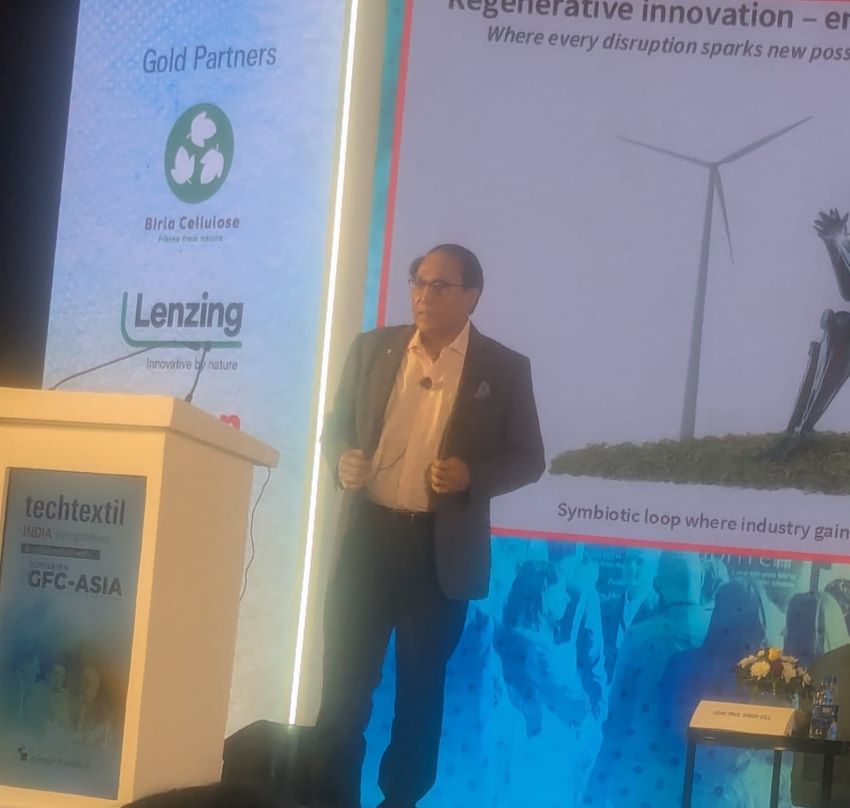FW
A denim expo will be held in Bangladesh on November 8 and 9, 2016 where about 8,000 visitors, including buyers and denim connoisseurs, from across the world are expected to attend. Around 100 exhibitors, including readymade garment manufacturers and denim fabric mills from Bangladesh and 17 other countries, will display their products.
Participants include entrepreneurs from the apparel sector, apparel traders, fashion professionals and industry stakeholders from Europe, US, UK, Germany, Italy, India, China, Pakistan, Vietnam, Singapore, Thailand, Turkey, Japan, Spain and Brazil.
The last edition of the denim expo held in April this year was attended by 4,000 trade visitors from around the world. A total of 50 participants, 37 foreign companies from 13 countries took part in the expo to display their products. Bangladesh Denim Expo, a non-profit and non-government organization, organises the international denim trade show in Bangladesh to promote Brand Bangladesh in the global denim industry.
On the backdrop of the huge response from exhibitors and visitors, the expo size has been doubled. This is the fifth edition. For the first time, the expo will be held in two halls. The expo acts as a hub for players on the international denim scene to mingle with colleagues, make new contacts and broker deals.
www.bangladeshdenimexpo.com/
Apparel Training & Design Centre (ATDC), with its affordable courses for skill development, has decided to empower the youth. To spread awareness regarding them a marathon ‘Run for Skills’ was organised by the Centre. The marathon started from ATDC Noida and culminated at the same place covering major parts of Noida, in-between stopping at Metro Hospital and Nehru International Public School. The marathon was flagged off by district magistrate Nagendra Pratap Singh. The event was put together to move one step closer to achieving the dream of ‘Skilled India’ by the team led by Lalit Thukral, Convenor, LMC, Noida Cluster, Darlie Koshy, DG & CEO, ATDC.
“The goal of Skill India is to create opportunities, space and scope for the development of talent of Indians and identify new sectors for skill development. It aims to provide training and skill development to 500 million youth by 2020, and ATDC should be well appreciated to move one step forwards towards Skill India goal,” said Singh. Added Koshy, “As a vocational training network, we at ATDC realise the importance of imparting skill to empower the unemployed youth. It is not just about skilling them; it is about making them self-confident and ready for the future. ” Over 150 students, volunteers and faculty members took part in the marathon.
With the vision of “Imparting skills and improving lives”, ATDC is the single largest vocational training provider for the apparel sector in India. Under the leadership of Koshy, it has got the ‘Best Vocational Training Provider (VTP) Training 2016-Gold’ by ASSOCHAM. The staff of ATDC has been working to train the youth and women for the last 25 years. This event reflected their goal of skilling as many people as possible and making them self-reliant.
The All Pakistan Textile Mills Association (APTMA) has strongly condemned media reports about Pakistan exporting cotton to India saying that it was the last nail on the coffin of the ailing textile industry in the country. In a statement, chairman APTMA, Tariq Saud said export of cotton from India in the absence of determination of crop size for the year 2016-17 is against the domestic textile industry. “The failure of local cotton crop in 2015-16 by about 35 per cent has already placed extra burden on the industry to import about 4 million bales of cotton to meet its consumption requirement,” he says.
He said cultivation of cotton this year is expected to decline by approximately 25 per cent which will ultimately decline the availability of cotton to the spinning industry. This will compel them to import cotton at 3 per cent custom duty at the import stage or otherwise exclude import of cotton from custom duty so that industry may remain competitive. Saud urged the government to provide level playing field and stop export of raw cotton till the determination of size of cotton crop for the next season or otherwise remove 3% custom duty on import of cotton.
"Asian fashion brands from South Korea, China and Japan are becoming serious rivals of their Western peers as Asian consumers become increasingly confident in their own style and take pride in buying home-grown labels. Most of these consumers are under 35, Internet-savvy and increasingly on the hunt for small, cool, original brands that will make them stand out from their parents, fashion executives and retailers say."

Asian fashion brands from South Korea, China and Japan are becoming serious rivals of their Western peers as Asian consumers become increasingly confident in their own style and take pride in buying home-grown labels. Most of these consumers are under 35, Internet-savvy and increasingly on the hunt for small, cool, original brands that will make them stand out from their parents, fashion executives and retailers say.
Fashion experts say, high quality is no longer the preserve of Western luxury brands and Asian brands are attracting attention as they experiment with new textiles and materials, facilitated by their local manufacturing base. Big luxury brands such as Prada, Kering's Bottega Veneta and Tod's, already suffering from plunging sales due to growing threat from East and are likely to face further problems. This also due to excessive price increases, over-exposure in certain markets such as China and mega-brand fatigue.
Asian brands riding high

Chinese fashion brands, such as Ms Min and Comme moi, are the fastest- growing contemporary labels sold at department store Lane Crawford, with outlets across China and Hong Kong, says chairman Andrew Keith. Lane Crawford also sells Korean menswear brands such as Woo Young Mi and expects to start selling Korean womenswear soon. Lane Crawford has seen its assortment of Chinese labels grow over the past four years to more than 30, from just four. Twenty per cent of Chinese-designed clothes bought online are shipped outside China mainly to Chinese nationals living abroad who want access to these brands, Keith said.
High on Asians' shopping list are Japanese brands, such as Sacai and Tsumori Chisato, many of them older and better established than South Korean or Chinese labels. Lady Gaga regularly wears Japan's Roggykei, created in 2006 by two graduates from Osaka College of Design.
New styles an attraction
Meanwhile, Seoul, Tokyo and Shanghai have fast-expanding fashion weeks, sponsored by local industrial groups, showing dozens of budding brands. Some labels have moved West and started showing at Milan and Paris fashion weeks and opened shops there. Guo Pei, the Beijing-based designer, whose yellow long cape dress was worn by Rihanna at the Met Gala last year, started showing at Paris Couture week in January, while Chinese shoe brand Stella Luna, whose stilettos cost more than €500, has three free-standing shops in Paris.
Another Chinese-born designer Yiqing Yin, whose creations are sold in China, New York and Paris, won several European fashion awards and has been hailed by the international fashion press as one of the most promising designers of her generation. Popular Korean brand SJYP, run by duo Steve Jung and Yoni Pai, sells in Europe and the United States, including at Selfridges in London and Opening Ceremony in New York and Los Angeles, while Chinese-born Uma Wang, a graduate of London's Central Saint Martins design school, sells in China and in Europe, including at l'Eclaireur in Paris. She also shows at Milan Fashion week.
Support from big businesses
Samsung C&T, affiliated to Samsung Electronics, maker of Apple rival Galaxy smartphones, is one of the biggest corporate investors in Seoul's up-and-coming fashion scene. Every year, it gives $100,000 to two or three designers to help them develop their collection and since 2005 has invested $2.7 million in 19 design teams through the Samsung Fashion & Design Fund. Samsung's fashion unit has a stable of brands, ranging from Korean brand Bean Pole to Belgian fashion label Ann Demeulemeester.
Koreans' self-esteem and self-confidence has been boosted by the power of 'K culture' and this is also why Korean and other Asian brands have started to become more popular, feels Sung-Joo Kim, one of Korea's most high-profile female entrepreneurs. She owns and runs German luxury leather goods brand MCM, known for its $700 studded logo-embossed canvas backpacks. Kim, who previously developed Gucci's Korean business, also pointed out that Asian brands cater better to Asian women's more petite shape
'Made in Asia, designed in Asia' has become cool, and the stigma that Asian brands had is disappearing fast. What’s more, Asian brands are also attracting interest from Western buyers.
With the 2016 Autumn edition of Intertextile Shanghai Apparel Fabrics to be held from October11 to 13, the attention of global apparel fabrics and accessories industry has begun to focus on the same. Over 5,000 exhibitors from more than 25 countries and regions will showcase their products across 260,000 sq.mt. of exhibition space at the Nation Exhibition and Convention Center (Shanghai). To ensure fair participants easily identify their target suppliers and buyers with so much on offer, a number of well-distinguished product zones are to be featured this year too.
In response to strong growth in the global active wear market, Intertextile Shanghai launched its first Functional Lab at the 2015 Autumn Edition. The zone has quickly garnered attention with both exhibitors and buyers praising its effectiveness for capturing the opportunities in this high-potential market. Carrying on, the Functional Lab is set to return this October.
As of this month, two pavilions, organised by INVISTA and Gyeongbuk Natural Color Industry Institute, as well as innovators from China, Hong Kong, Israel, Japan and Korea have already reserved their space to present a spectrum of the latest innovative products.
Clothing brands have told global sustainability assessment company Textile Exchange (TE) they would not use its Responsible Wool Standard (RWS) if mulesing was allowed. Its second stakeholder review of RWS, concluded recently, and brands told TE the standard cannot succeed without the support of brands driving demand.
In the latest RWS Mulesing Position Paper released to Sheep Central, TE said welfare groups told Australian wool industry they had 10 years to eliminate mulesing, and that the industry needs a strong and clear signal that it is not acceptable. The completed RWS is due for release soon and TE is conducting training on the standard with the sourcing offices of a number of global brands in Europe, Asia and Japan.
RWS consultation on mulesing question culminated in a panel discussion that was held as an open webinar last month. During the discussion, Textile Exchange had representation from animal welfare groups, brands, a pain relief specialist, a Merino breeder, a prominent wool trader and processor, a veterinarian, a wool supplier and a wool farmer.
As per the paper, all perspectives were shared and although there were arguments for allowing mulesing with pain relief, the overwhelming message from brands and animal welfare groups was that the RWS would not be an acceptable sourcing option if Mulesing – under any conditions – is allowed.
Forget carpet, New Zealand's coarse wool, could one day turn up as an ingredient in a food supplement or a Lego piece, if a new research project turns out successful. A $21 million research being jointly conducted by the Wool Industry Research Ltd (WIRL) and the Ministry of Business, Innovation and Employment (MBIE) is attempting to unravel new methods in which coarse wool could be used. As far as synthetics is concerned, wool has been in retreat for decades, but WIRL manager Ian Cuthbertson believes this could change if new uses are found for the product which was once New Zealand's biggest export earner. He points out instead of sending unprocessed fibre as is done now, at $6 a kg, wool could be sent as an ingredient at $16 a kg.
The seven-year research focuses on new ways to use wool as a source of high value Keratin. The program will also work with traditional manufacturing industries to develop new technical textiles. And as Cuthbertson believes the program is essential for the future of the industry since the price farmers receive barely covers the cost of production. To get the industry thriving again, it needs to get around $7-8 a kg. At the moment it is $6 but over the last 15 years, it has been only about $4.
The program will be rolled out at $3 million a year with WIRL and the wool industry funding 60 per cent and 40 per cent by MBIE respectively. WIRL is a fully owned subsidiary of Wool Research Organisation of NZ that underwrites the industry funding component of the new partnership.
ITME is completing four decades and the 10th edition of ITME 2016, the once in four year mega exhibition has garnered much interest, excitement and anticipation amongst national and international business community, government officials, students, academicians alike. Riding high on ‘Make in India’ campaign, this B2B exhibition has attracted big and small companies from across the globe.
Exciting display of engineering, razor sharp intellectuals presenting technology papers, panel discussions on varied current topics, rustic artisans weaving magic with bare hands, students impressing the industry, passion and creativity at its best, tradition in its glory, experience it all at India ITME 2016.
The event is supported by Department of Heavy Industry, Textile Ministry and INDEXTB, government of Gujarat as state partner, making this the only privately organized exhibition supported by central and state government. India ITME-2016 is also supported by 73 international industry associations, universities and Media Partners across the globe. The exhibitors are from 37 countries.
Starting on December 3, 2016 over six days, the 10th India ITME shall see around 1,50,000 visitors from all around the world and India. Visitors and delegations from countries like Pakistan, Bangladesh, Sri Lanka, Thailand, Malaysia, Indonesia, Kenya, Ethiopia, Middle East have already registered. Extensive promotional activities are ongoing in Ethiopia, China, Egypt, Iran, Srilanka, Bangladesh and Turkey.
The Foreign Buyers Association of the Philippines (Fobap) asked the government support to address roadblocks to the growth of garments and hard goods sectors. Fobap president Robert Young said his group’s export sales of garments were projected to hit $1 billion, while those of hard goods were seen to reach $200 million in 2016. Fobap said among the major roadblocks to the growth of garment and hard goods industry were high power cost, wages and financing.
Other Southeast Asian countries such as Myanmar, Cambodia and Vietnam partly subsidise power, wages and financing cost of their dollar-earning industries, Young said. He also underscored the need for the country to invest massively in infrastructure development.
Fobap also pushed for the establishment of more factories to meet import orders. The group sees garments exports increasing 20 per cent in the first half of 2017. The high jump in revenues of the garments sector is due to the fact that buyers are now seeing the other players in the Asean countries a little bit facing some risks as far as political and social aspects are concerned. They are not putting all their eggs in one basket so they are placing some orders in the Philippines, Young said.
Meanwhile, he urged companies and industries to upgrade the skills of their workers, as the machines being used by neighboring Asian countries were already modernised.
Denim Expert (DEL), Bangladesh has announced it has received support from the German Federal Ministry for Economic Cooperation and Development's ‘develoPPP.de programme,’ which subsidises sustainable projects in developing and emerging markets. These types of developmental collaborations with the private sector are aimed at creating developmental effectiveness to improve the living conditions in developing and emerging markets.
The program is co-financed by the DEG (German Investment and Development Company). In order to strengthen the denim business in the long term, the textile industry's social and ecological standards must be improved. The develoPPP.de programme supports DEL financially and structurally to enable us to put our sustainable ideas into practice, said Mostafiz Uddin, CEO Denim Expert Ltd.
The vertically integrated company DEL, which operates from Chittagong, describes itself as a leader in sustainability which helped it receive German support. The developmental collaboration was launched in December 2015 and is designed for two years. DEL also qualified for the programme due to its great commitment regarding the reduction of water and energy consumption as well as the use of chemicals. This is exactly where the denim industry struggles: To achieve the typical "used look" of jeans, traditional factories apply many washings and chemicals. Responsibility toward natural resources such as gas, oil, and water, or the reduction of chemicals and proper waste water treatment are hardly found.












